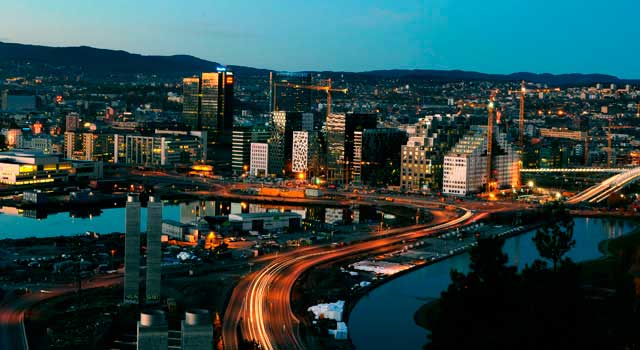 Oslo
Oslo
The charms of Oslo cannot be described in a few words. The capital of Norway boasts one of the most beautiful locations in Europe, because it is sandwiched between the mountains and the long fjord, resembling a swan's neck. Oslo has long been called the Nordic City of Light, and that's why, that despite the small population, the city is literally bustling with life. Finally, Oslo can also be included among the most important cultural and art centers in Northern Europe.
Medieval Oslo was located approx. 1,5 km east of today's center. However, a huge fire, which broke in 1624 r., devastated most of the city, and King Christian IV Oldenburg decided to rebuild the Norwegian capital closer to Akershus Fortress. This stronghold, situated on the eastern shore of Pipervika Bay, it was for a long time the official residence of the Norwegian rulers, and today it is the seat of the Government of Norway. The fortress is also a big tourist attraction, and within its walls there is the Royal Mausoleum and important museums - the Museum of the Resistance Movement and the Museum of the Armed Forces. It is also worth mentioning, that Akershus Fortress was never captured by hostile Norwegian troops.
Opposite the Akershus Fortress, on the western side of Pipervika Bay, the Aker Brygge waterfront is full of elegant shops, restaurant. The quay is visited by over a dozen million people every year, which means, that it is one of the most popular places in all of Norway! North of Aker Brygge rises the Town Hall - one of the tallest buildings in Oslo. The town hall building is basically composed of three parts, and Norwegians laugh a lot, that each of them resembles sweetish, goat cheese geitost - a real Norwegian delicacy.
Almost right behind the Town Hall, perpendicular to the Oslo Fjord, the main representative avenue of the city runs - Karl Johans gate. The most important ones are situated along the entire avenue, Oslo's secular and sacred buildings. Elegant rises on the west side, Classicist Royal Palace, which is now the official seat of the Norwegian Royal Family. The palace is surrounded by the beautiful Royal Park, which decorates, among others. a statue of King Charles III Jan and a sculpture by Gustav Vigeland, featuring the famous Norwegian feminist Camilla Collett and the famous Norwegian mathematician - Niels Henrik Abel. Going east of the Palace, you can see two more, magnificent edifices - the 19th-century edifice of the National Theater and the Neo-Romanesque Parliament Building. At the very end of Karl Johans gate rises the Cathedral - the most important religious building in Oslo and at the same time the official temple of the Norwegian Royal Family. In the very center of Oslo, two more buildings deserve special attention, and these are the Opera House and the Nobel Peace Center. Opera House, located on the bay of Bispevika and open in 2008 r., it's a phenomenal building (one of the largest in all of Norway), with three auditoriums and topped with a stone roof, which descends steeply towards the quay. Nobel Peace Center, situated between the Town Hall and Aker Brygge, it is in turn an institution dedicated to the Nobel Peace Prize - its founder, laureates and all matters relating to peace in the world.
Many attractions can also be found in the western part of Oslo. The Bygdøy Peninsula is famous for its excellent museum facilities, of which the most interesting is the Norwegian Folk Museum, Viking Ship Museum, Norwegian Maritime Museum and the Kon-Tiki Museum. The Norwegian Folk Museum is an excellent open-air museum, in which over 150 examples of wooden and brick rural and urban architecture, as well as thousands, from all over Norway, valuable artifacts. At the Viking Ship Museum, as its name suggests, antique boats were placed in turn, built by Scandinavian warriors in the 9th century. There are three boats in the museum, excavated w Oseberg, Tune in Gokstad. The Norwegian Maritime Museum and the Kon-Tiki Museum are institutions dedicated to famous Norwegian travelers, including Fridtjof Nansen, Roaldowi Amundsenowi i Thorowi Heyerdahlowi. In the Maritime Museum, you can see the famous ship Gjøa, on which Amundsen sailed from Europe to Asia via the Arctic Ocean, while at the Kon-Tiki Museum - the legendary raft, on which Thor Heyerdahl went in 1947 r. for an expedition from Peru to the Polynesian islands. In the north-eastern part of Oslo, there is also the famous Vigeland Park, that is, a sculptural and garden composition, composed of over 200 sculptures!
While in Oslo, you cannot miss the Munch Museum, the most famous in Oslo, and the National Art Museum, Architecture and Design. The Munch Museum currently collects over 20 thousand. various works of the artist - from paintings, by drawings and graphics, right up to woodcuts or woodcut blocks. National Museum of Art, Architecture and Design consists of five departments, among which the National Gallery and the Museum of Applied Arts deserve special attention. In the National Gallery you can see wonderful works of Norwegian and foreign painters, including mainly French Impressionists and Post-Impressionists. In turn, the Museum of Applied Arts presents, among others. valuable collections of ceramics, textiles and furniture. The last major attraction, which is definitely not to be missed, there is a ski jump in the outskirts of Oslo, in Holmenknollen. For Poles, the place is so special, that Adam Małysz triumphed here five times.
